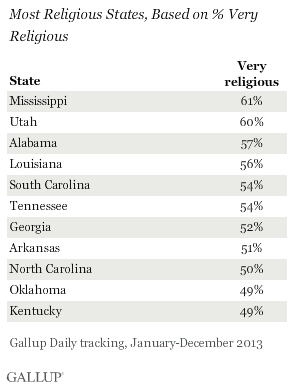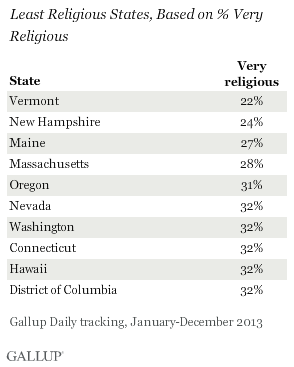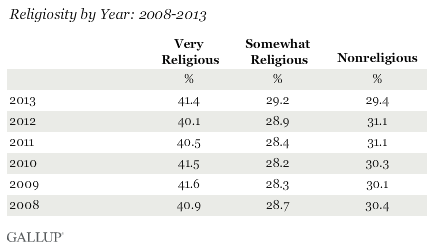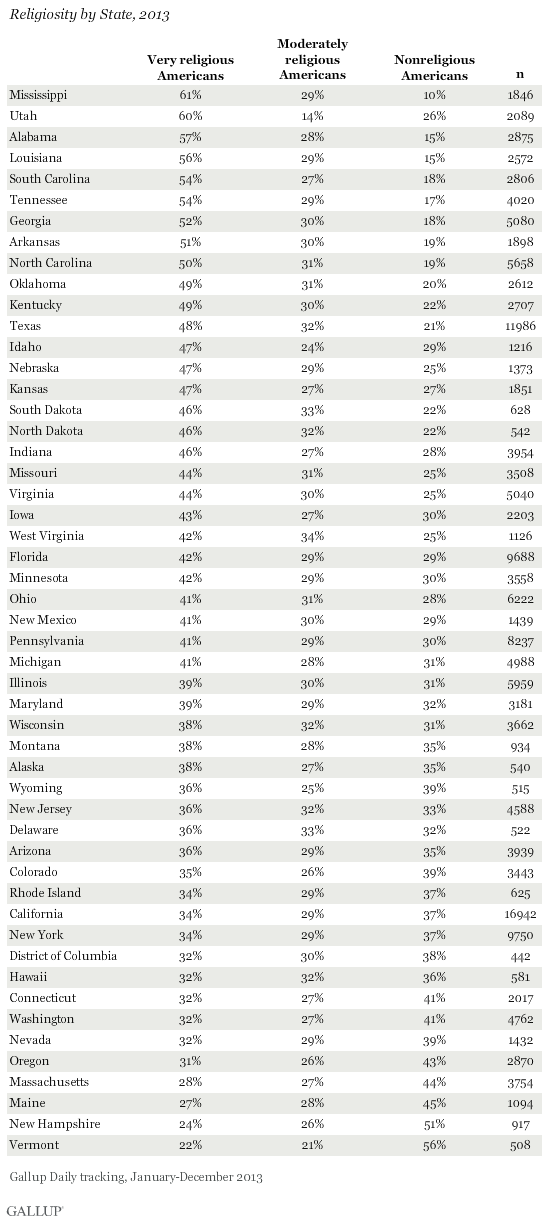PRINCETON, NJ -- Religiousness across the U.S. in 2013 remained similar to previous years. With 61% of its residents classified as very religious, Mississippi held on to its position as the most religious state, while Vermont, with 22% very religious residents, remained the least religious. The most religious states were in the South, except for Utah, while the least religious states were clustered in New England and the West.


These state-by-state results are based on more than 174,000 interviews conducted as part of Gallup Daily tracking in 2013, including more than 500 interviews conducted in each state and 442 in the District of Columbia. Complete results and sample sizes are on page 2.
 |
| Explore complete state data > |
Gallup classifies Americans as very religious if they say religion is an important part of their daily lives and that they attend religious services every week or almost every week. More than four in 10 Americans nationwide (41%) fit this classification in 2013. Twenty-nine percent of Americans were nonreligious, saying religion is not an important part of their daily lives and that they seldom or never attend religious services. The remaining 29% were moderately religious, saying religion is important in their lives but that they do not attend services regularly, or that religion is not important but that they still attend services.
Gallup began tracking religion using this measure in 2008, and the nationwide proportions of Americans in each of the three religious categories have remained generally stable since then. The percentage "very religious" is slightly higher in 2013 than it was in 2012, 2011, and 2008, while the percentage of nonreligious Americans is slightly lower in 2013 than in any previous year.

Although there have been minor changes in the rank-order of the most religious and the least religious states between 2008 and 2013, the broad pattern has remained similar year after year. Ten of the 11 most religious states in 2013 are in the South. The exception is Utah, a majority of whose residents identify as Mormons -- the most religious of any major religious group in the country.
The 10 least religious states in 2013 are from two areas -- New England and the West -- plus the District of Columbia. The New England states of Vermont and New Hampshire continue to be the least religious states in the union.
Implications
The U.S. remains a religious nation -- with about seven in 10 Americans classified as very or moderately religious -- and the nation's residents as a whole are about as religious now as they were in 2008. The religiousness of the nation's residents, however, does vary substantially by state and region. The most religious areas continue to be the South, the state of Utah, and the Midwestern Plains states, while the least religious areas are mostly in New England, the Pacific Northwest, and other Western states.
These regional variations are quite stable and look generally the same now as they did six years ago. They reflect basic state cultures that are highly persistent, even as states experience demographic changes through births, deaths, and migration.
The differences in religiousness across states can have several causes. For example, the Southern states have a higher percentage of Protestants than the national average, and Protestants have above-average religiousness. The New England states have a higher percentage of those with no religious identity at all, and these residents are of course much lower than average on the religiousness scale. Still, previous research shows that even among those in the different regions who have the same religious identity, state-level cultural differences still affect average religiousness. Protestants in Mississippi are more religious than Protestants in Vermont, and those with no religious identity in Mississippi are more religious than those with no religious identity in Vermont.
Additionally, although states vary significantly in their racial and ethnic composition, differences in religiosity between states persist even among residents of the same races. Whites in Mississippi are more religious than whites in Vermont, and blacks in New England are less religious than blacks in the South.
Utah is the exceptional state. Mormons are the most religious of any category or denomination Gallup routinely measures, and Utah's majority Mormon population clearly explains why Utah stands out so remarkably from its much less religious neighboring states.
Gallup's "State of the States" series reveals state-by-state differences on political, economic, and well-being measures Gallup tracks each day. New stories based on full-year 2013 data will be released in the coming months.
Survey Methods
Results for this Gallup poll are based on telephone interviews conducted Jan. 2-Dec. 29, 2013, on the Gallup Daily tracking survey, with a random sample of 174,699 adults, aged 18 and older, living in all 50 U.S. states and the District of Columbia.
For results based on the total sample of national adults, the margin of sampling error is ±1 percentage point at the 95% confidence level.
Margins of error for individual states are no greater than ±6 percentage points, and are ±3 percentage points in most states. The margin of error for the District of Columbia is ±6 percentage points.
Interviews are conducted with respondents on landline telephones and cellular phones, with interviews conducted in Spanish for respondents who are primarily Spanish-speaking. Each sample of national adults includes a minimum quota of 50% cellphone respondents and 50% landline respondents, with additional minimum quotas by time zone within region. Landline and cellular telephone numbers are selected using random-digit-dial methods. Landline respondents are chosen at random within each household on the basis of which member had the most recent birthday.
Samples are weighted to correct for unequal selection probability, nonresponse, and double coverage of landline and cell users in the two sampling frames. They are also weighted to match the national demographics of gender, age, race, Hispanic ethnicity, education, region, population density, and phone status (cellphone only/landline only/both, cellphone mostly, and having an unlisted landline number). Demographic weighting targets are based on the most recent Current Population Survey figures for the aged 18 and older U.S. population. Phone status targets are based on the most recent National Health Interview Survey. Population density targets are based on the most recent U.S. census. All reported margins of sampling error include the computed design effects for weighting.
In addition to sampling error, question wording and practical difficulties in conducting surveys can introduce error or bias into the findings of public opinion polls.
For more details on Gallup's polling methodology, visit www.gallup.com.
